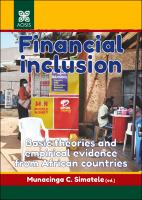Financial inclusion
Basic theories and empirical evidence from African countries
| dc.contributor.author | Simatele, Munacinga C. | |
| dc.contributor.author | Dube, Ziphozethu | |
| dc.contributor.author | Khumalo, Sibanisezwe | |
| dc.contributor.author | Ssonko, George W. | |
| dc.contributor.author | Kawooya, Duncan R. | |
| dc.contributor.author | Bwalya, Miselo | |
| dc.contributor.author | Dlamini, Phindile G. | |
| dc.contributor.author | Kichini, Gilbert | |
| dc.contributor.author | Kabange, Martin M. | |
| dc.contributor.author | Dlova, Mzwanele | |
| dc.contributor.author | Mishi, Syden | |
| dc.contributor.author | Mutyavaviri, Timothy | |
| dc.contributor.editor | Simatele, Munacinga C. | |
| dc.date.accessioned | 2022-04-08T09:44:40Z | |
| dc.date.available | 2022-04-08T09:44:40Z | |
| dc.date.issued | 2021 | |
| dc.identifier | ONIX_20220408_9781776341818_14 | |
| dc.identifier | ONIX_20220408_9781776341818_14 | |
| dc.identifier | OCN: 1316786292 | |
| dc.identifier.uri | https://library.oapen.org/handle/20.500.12657/53907 | |
| dc.description.abstract | Financial inclusion has been noted as a key driver of poverty alleviation and growth. Yet, most of the scholarly work that exists lacks a comprehensive discussion of how the poor interact with financial services and the channels through which such services can affect their livelihoods. This book offers researchers who focus on financial inclusion and African economies a one stop resource for understanding the channels of transmission for financial inclusion as well as an application of these channels through original country specific empirical papers. The book provides a back-to-basics presentation of the transmission of financial services to growth and poverty. This theoretical discussion is complemented by an empirical presentation of the various services used by the poor, with a focus on Africa. Case studies of financial inclusion in six African countries cover a broad range of topics most important to African countries and highlight the unique African setting. These empirical papers provide important learning points. Firstly, hybrid financial institutions such as cooperative financial institutions and financial social entrepreneurs are the best way to increase financial inclusion in Africa. They provide important vehicles to circumventing the restrictive and exclusive bank-based financial markets typical of African economies. Secondly, digital finance is a potent tool in improving financial access and usage in Africa, and its impact on poverty operates through both traditional and nontraditional financial instruments. Thirdly, investment in infrastructure which supports complementary markets is critical and is likely to have a greater effect on credit rationing than direct provision of credit to small businesses. | |
| dc.language | English | |
| dc.subject.classification | thema EDItEUR::K Economics, Finance, Business and Management | en_US |
| dc.subject.other | Poverty | |
| dc.subject.other | microfinancing | |
| dc.subject.other | savings | |
| dc.subject.other | microcredit | |
| dc.subject.other | financial inclusion | |
| dc.subject.other | Africa | |
| dc.subject.other | African finance | |
| dc.title | Financial inclusion | |
| dc.title.alternative | Basic theories and empirical evidence from African countries | |
| dc.type | book | |
| oapen.identifier.doi | 10.4102/aosis.2021.BK255 | |
| oapen.relation.isPublishedBy | d7387d49-5f5c-4cd8-8640-ed0a752627b7 | |
| oapen.relation.isFundedBy | North-West University | |
| oapen.relation.isbn | 9781776341818 | |
| oapen.relation.isbn | 9781776341795 | |
| oapen.relation.isbn | 9781776341801 | |
| oapen.pages | 314 | |
| oapen.place.publication | Durbanville |

